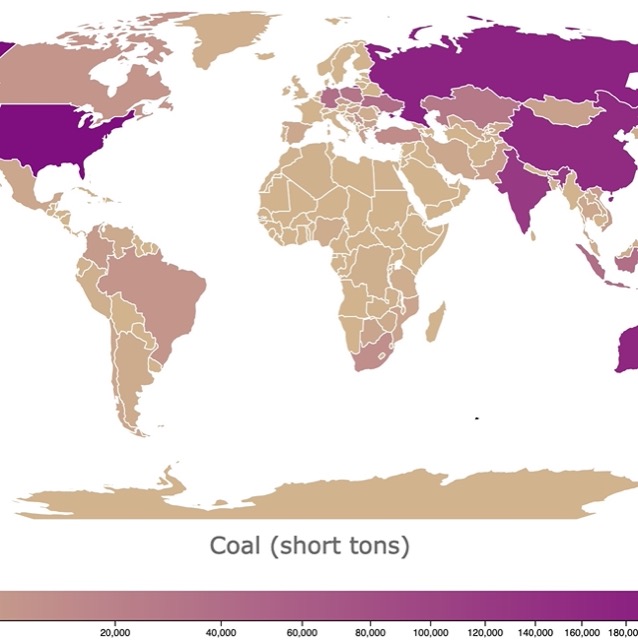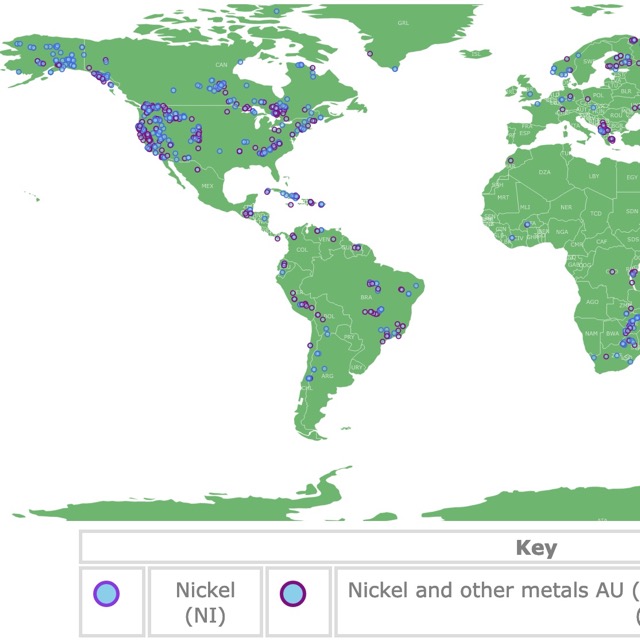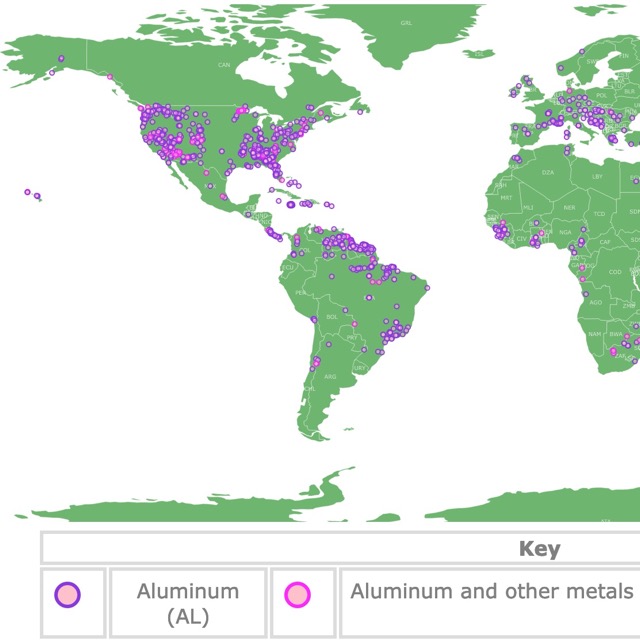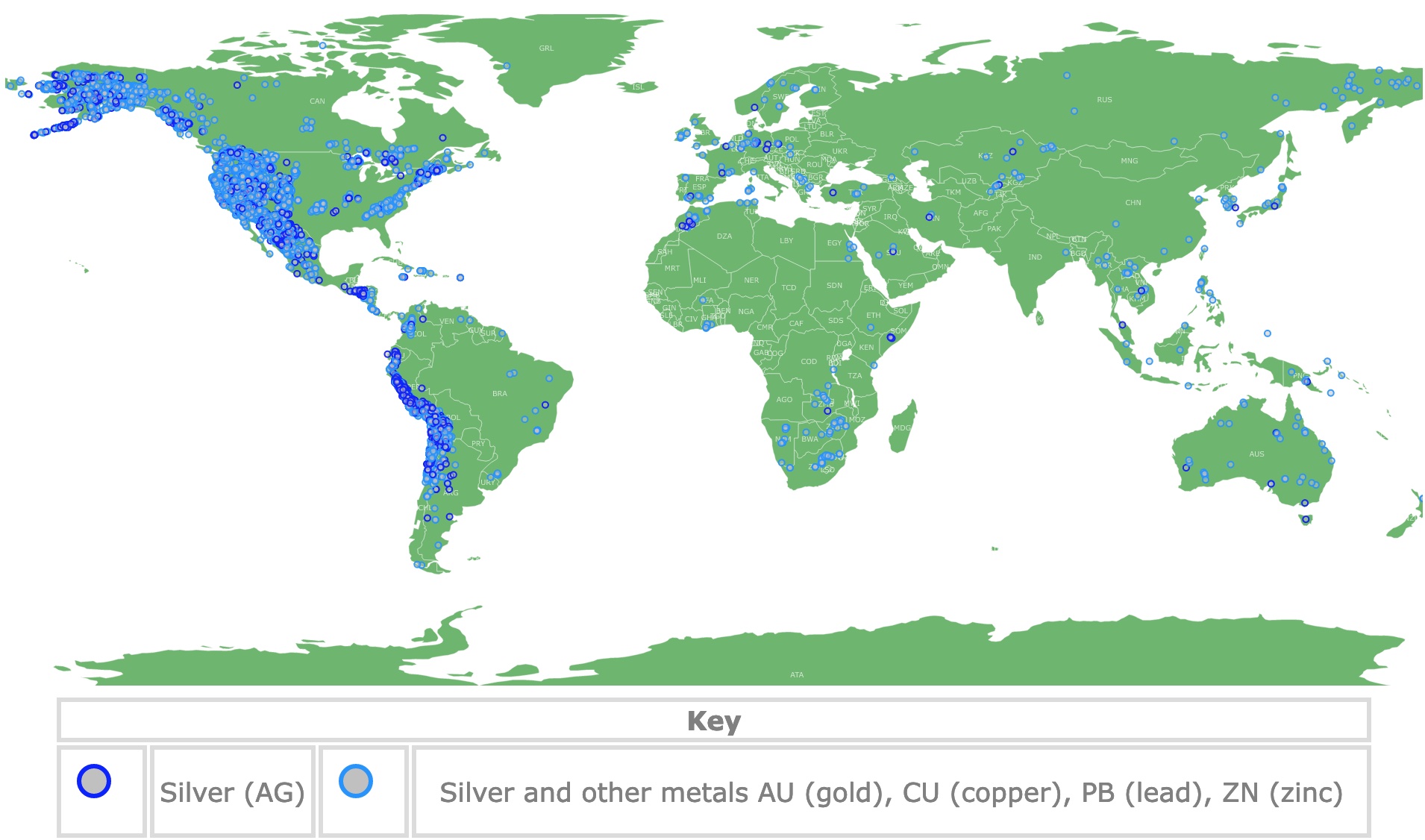Map of Silver Deposits Worldwide
This map depicts World Silver Deposits in gray. For more detail, hover over the map. To take a closer look, zoom in. For more information, scroll down.
| Key | |||
|---|---|---|---|
| Silver (AG) | Silver and other metals AU (gold), CU (copper), PB (lead), ZN (zinc) | ||
SILVER
Silver is a chemical element with atomic number 47. Silver is classified as a transition metal and is solid at room temperature.
The symbol Ag for silver derives from the Latin argentum and Sanscrit argunas, which means "bright".
Pure silver has the whitest color and the highest optical reflectivity. It is a relatively soft and shiny metal. It tarnishes slowly in the air as sulfur compounds react with the surface forming black silver sulfide.
If you think its time to invest in silver, gold, or other commodities, Vector Vest can help. Precious Metals' purchasing power and wealth preservation have a proven record of accomplishment. To start today, Go Here!
Uses of Silver
Silver has been considered a precious metal for 6,000 years. It was first used as currency in 700 B.C. and has been a trading metal in nearly every culture.
It has been used for jewelry, utensils, and as a basis of a monetary system.
To this day, its intrinsic value persists. It has earned a place in investors' portfolios and is a time-tested commodity..
Silver forms compounds with halogens and forms Silver halides or silver salts like AgBr. Silver halides are photosensitive, therefore, useful in photography. This is one of its most common uses, even though it is declining due to digital photography.
Silver's catalytic properties make it ideal for use as a catalyst in oxidation reactions.
Silver has the highest thermal and electrical conductivity, which makes it useful for electrical contacts and batteries. It is used for electronic products like silver paints for printed circuits.
Due to its reflectivity, it can be used for making mirrors.
It is also used in dental alloys, the health industry, solder, and brazing alloys, among other uses. Source: RSC.
To learn about investment in silver, Amazon has How to Invest in Gold & Silver: A Complete Guide with a Focus on Mining Stocks. This is a practical guide for investors new to the emerging gold and silver markets. Written in clear layman’s terms, this book is packed with information on managing the risk of gold and silver assets. A step-by-step strategy for investing in bullion and coins, and on using ETFs (Electronic Trading Funds).
Sterling Silver
Sterling silver is an alloyed form of silver. It is more suitable to use in jewelery and other metalwork.
Fine silver is 99.9% pure silver. Like this, silver is beautiful and suffers from minimal tarnish. Nevertheless, it is too soft and malleable for many uses, including jewellery.
Instead, fine silver is alloyed with copper to create sterling silver, which is 92.5% pure silver and 7.5% copper. The copper makes the silver, harder, more durable and much better to work with.
This percentage of fine silver is why you will sometimes see sterling silver referred to as '925 silver' or hallmarked with a 925 stamp; SW.
Silver Geology
The abundance of silver in the Earth's crust is 0.08 parts per million.
Native silver is the silver found in its pure metallic form in nature. Native metals can be found alone or in alloys. A common natural silver alloy is Electrum. Electrum is made of gold and silver.
Silver is rarely found as a native metal. This is because, over geological time scales, very few metals can resist natural weathering processes like oxidation.
Most native silver is found to be associated with hydrothermal activity. In such locations, it is found in veins and cavity fillings.
Silver is also found as a mineral and a trace metal. The most abundant form is as a trace metal with other metal ores.
If you want to learn more about metals' use and origin, you can buy the Critical Metals Handbook from Amazon. This book discusses the long-term availability of secure and adequate supplies of the metals needed by society. For many of these, we have little information on how they are concentrated in the Earth’s crust, how to extract them from their ores, and how to use, recycle and dispose of them effectively and safely.
Minerals with Silver
Silver can be found in about 40 mineral species. All these minerals are rare. The most common are proustite, acanthite, and pyrargyrite.
These minerals may be classified as halides, sulfides, tellurides, silicates, and more.
Silver Occurrence and Extraction
Silver is mined as an ore of sulfide, acanthite, or argentite. Silver is found with copper, copper-nickel, lead, and lead-zinc.
Therefore, its production requires smelting.
Only 27% of silver derives from mining activities, where silver comprises the primary source of revenue.
The remaining 73% comes from projects where silver is a by-product of mining other metals, like copper, lead, and zinc.
Silver ore is mined through open-pit and underground methods. The open pit method involves using heavy machinery to mine deposits near Earth's surface.
In underground mining, tunneling deep shafts into the ground allows for ore extraction. Source: Globalxetfs.
Learning about mining and metals does not make you richer, but buying and selling them will. Owning physical precious metals in a retirement account is a prudent and secure plan for your financial future. For more information go to Vector Vest.
Silver Reserves
In 2014 it was estimated that there were 26,800 metric tons of silver available worldwide.
Below is a list of countries with the most significant silver reserves.
If you wish to read more about silver and its mining history, you can get it from Amazon Aspen: The History of a Silver Mining Town, 1879 - 1893. This book tells the story of how prospectors created Aspen and turned it into a major town.
Silver in Peru
Peru has about 98,000 tonnes of silver. More than any other country in the world.
In 2022 Peru was also one of the major silver producers. It put out 3,100 tonnes, making it the third-largest producer that year.
Most of Peru's silver is produced at the Antamina mine, located in the province of Huari. Mine produces copper primarily, but silver is one of its main outputs.
Silver in China
China has the second largest silver reserves, with 71,000 tonnes. China was also the second-largest silver producer in 2022.
Most of China's production is a by-product of other metals.
Silver in Poland
Poland has the third largest reserves. Nevertheless, Poland is not a top producer.
It is estimated that Poland has reserves equal to 65,000 tonnes. Source: Investing News.
Other countries with large reserves include Australia, Russia, Mexico, Chile, U.S.A., and Bolivia.
It is important to keep in mind that reserves are different from production. Many of these countries are not actively mining silver out of every deposit.
Largest Silver Mines
Polkowice-Sieroszowice Mine, Poland
Polkowice-Sieroszowice Mine is located in the Glogow copper belt of Poland. This underground mine uses a blasting method to extract the silver.
In 2020, 1,111 tonnes (39.2 Moz) of silver were mined from this mine, making it the world's largest.
Peñasquito Mine, Mexico
Peñasquito is a two-pit open mine, the largest in Mexico. This poly-metallic mine has gold, zink, copper, and lead.
Peñasquito has the world’s largest silver reserves, which are calculated to be around 24,650 tonnes (869.52 Moz.)
Dukat, Russia
This is Russia's largest primary silver mine.
Dukat has open-pit and underground mines that can keep producing until 2026.
Sindesar Khurd Mine, India
This is India's largest silver mine. It is located in the state of Rajasthan.
This is an underground mine that also produces zinc and lead. Source: abc Dust.
Saucito Mine, Mexico
Saucito is an underground mine with a shaft depth of about 1 Km.
Besides silver, this mine produces gold, lead, and zinc.
Resources for World Silver Deposits Map
The shapefiles with silver deposits are from U.S. Geological Survey mineral databases; MRDS and MAS/MILS Data Series 52 By: E.J. McFaul, G.T. Mason, W.B. Ferguson, and B. R. Lipin. It can be downloaded from MRDATA.
The Shapefiles with countries were downloaded from Natural Earth.
This map will be updated with new data! To receive updates on this and more nature maps, join my email list!!!!!!!
Made by Luz K. Molina with D3.js.








